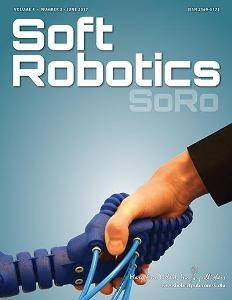Jul 26 2017
Soft-bodied robots offer the possibility for social engagement, and novel tactile human-robot interactions that require careful consideration of the potential for misplaced emotional attachments and personally and socially destructive behavior by users.
 Soft Robotics combines advances in biomedical engineering, biomechanics, mathematical modeling, biopolymer chemistry, computer science, and tissue engineering to present new approaches to the creation of robotic technology and devices that can undergo dramatic changes in shape and size in order to adapt to various environments. (Credit: Mary Ann Liebert, Inc., publishers)
Soft Robotics combines advances in biomedical engineering, biomechanics, mathematical modeling, biopolymer chemistry, computer science, and tissue engineering to present new approaches to the creation of robotic technology and devices that can undergo dramatic changes in shape and size in order to adapt to various environments. (Credit: Mary Ann Liebert, Inc., publishers)
The ethical challenges related to human-robot interactions and how these should contribute to soft robotics design in the context of social interaction are discussed in a compelling new article in Soft Robotics, a peer-reviewed journal from Mary Ann Liebert, Inc., publishers. The article is available free on the Soft Robotics website until August 25, 2017.
Thomas Arnold and Matthias Scheutz, Tufts University, Medford, MA coauthored the article entitled "The Tactile Ethics of Soft Robotics: Designing Wisely for Human-Robot Interaction." They examine a broad range of topics, including the ability of soft robots to touch and interact with their environments, the potential risks of humans forming one-directional emotional bonds with robots, and what social robots should be intended to accomplish. To illustrate some of the ethical challenges involved in soft robotics and the possible risks for society, the authors discuss the example of sex robots.
Drs. Arnold and Scheutz offer three general guidelines for how soft robotic technology should be developed within the context of social human-robot interaction. They encourage the soft robotics community to address these ethical challenges as a way of improving the quality and effectiveness of human-robot interactions. "Soft robot technology will soon bring us machines that interact directly with humans; it is essential that we start to think about the impact these might have on social situations. This paper outlines some of the major issues and provides excellent guidelines for a serious discussion of human-robot relationships," says Editor-in-Chief Barry A. Trimmer, PhD, who directs the Neuromechanics and Biomimetic Devices Laboratory at Tufts University (Medford, MA).